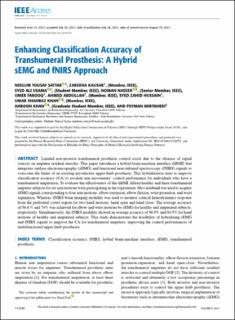| dc.contributor.author | Yousaf Sattar, Neelum | |
| dc.contributor.author | Kausar, Zareena | |
| dc.contributor.author | Usama, Syed Ali | |
| dc.contributor.author | Naseer, Noman | |
| dc.contributor.author | Farooq, Umer | |
| dc.contributor.author | Abdullah, Ahmed | |
| dc.contributor.author | Hussain, Syed Zahid | |
| dc.contributor.author | Shahbaz Khan, Umar | |
| dc.contributor.author | Khan, Haroon | |
| dc.contributor.author | Mirtaheri, Peyman | |
| dc.date.accessioned | 2023-02-23T07:53:00Z | |
| dc.date.available | 2023-02-23T07:53:00Z | |
| dc.date.created | 2021-08-13T11:03:58Z | |
| dc.date.issued | 2021-07-26 | |
| dc.identifier.citation | IEEE Access. 2021, 9 113246-113257. | en_US |
| dc.identifier.issn | 2169-3536 | |
| dc.identifier.uri | https://hdl.handle.net/11250/3053450 | |
| dc.description.abstract | Limited non-invasive transhumeral prosthesis control exists due to the absence of signal sources on amputee residual muscles. This paper introduces a hybrid brain-machine interface (hBMI) that integrates surface electromyography (sEMG) and functional near-infrared spectroscopy (fNIRS) signals to overcome the limits of an existing myoelectric upper-limb prosthesis. This hybridization aims to improve classification accuracy (CA) to escalate arm movements’ control performance for individuals who have a transhumeral amputation. To evaluate the effectiveness of this hBMI, fifteen healthy and three transhumeral amputee subjects for six arm motions were participating in the experiment. Myo armband was used to acquire sEMG signals corresponding to four arm motions: elbow extension, elbow flexion, wrist pronation, and wrist supination. Whereas, fNIRS brain imaging modality was used to monitor cortical hemodynamics response from the prefrontal cortex region for two hand motions: hand open and hand close. The average accuracy of 94.6 % and 74% was achieved for elbow and wrist motions by sEMG for healthy and amputated subjects, respectively. Simultaneously, the fNIRS modality showed an average accuracy of 96.9% and 94.5% for hand motions of healthy and amputated subjects. This study demonstrates the feasibility of hybridizing sEMG and fNIRS signals to improve the CA for transhumeral amputees, improving the control performances of multifunctional upper-limb prostheses. | en_US |
| dc.language.iso | eng | en_US |
| dc.publisher | Institute of Electrical and Electronics Engineers (IEEE) | en_US |
| dc.relation.ispartofseries | IEEE Access;Volume: 9 | |
| dc.rights | Navngivelse 4.0 Internasjonal | * |
| dc.rights.uri | http://creativecommons.org/licenses/by/4.0/deed.no | * |
| dc.title | Enhancing Classification Accuracy of Transhumeral Prosthesis: A Hybrid sEMG and fNIRS approach | en_US |
| dc.type | Peer reviewed | en_US |
| dc.type | Journal article | en_US |
| dc.description.version | publishedVersion | en_US |
| cristin.ispublished | true | |
| cristin.fulltext | original | |
| cristin.qualitycode | 1 | |
| dc.identifier.doi | https://doi.org/10.1109/ACCESS.2021.3099973 | |
| dc.identifier.cristin | 1925762 | |
| dc.source.journal | IEEE Access | en_US |
| dc.source.volume | 9 | en_US |
| dc.source.issue | 9 | en_US |
| dc.source.pagenumber | 113246-113257 | en_US |

